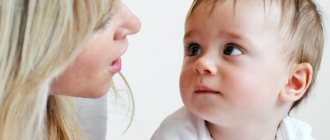November 22, 2021 Doctors and psychologists unanimously say: you need to start raising a child as early as possible, from his very birth. Some go even further, suggesting that learning should begin during pregnancy: it is believed that already in the womb the child can perfectly hear everything that is happening around him, so he needs to read books and turn on music. All this contributes to the earlier development of speech in the child, since the ability to speak is an acquired skill.
The child begins to pronounce the first conscious, “human” sounds at about six months, but these skills need to be developed immediately after birth. For full development, including speech development, a little person must feel care and attention from his parents. It is recommended to pick him up more often and talk to the child. This way, you will give him both physical and verbal contact, which will make him feel safe.
At the same time, this will contribute to the development of other senses and skills of the newborn. When a child speaks depends not only on the structure of his speech organ, but also on proper upbringing and training from the first days of life. If in the first weeks after birth the baby's sounds are limited to screaming, already in the second month his speech will change. At this time, individual sounds appear: at such moments, it is very important for the child to get the mother’s approval so that he is sure that he is doing everything correctly.
It is recommended to repeat the same sounds after him and accompany this with a smile. You can then add your own sounds as children learn by imitating adults. Another great way to develop your child's speech abilities is through music. In order for speech to develop in the correct way, it is advisable to play quiet but rhythmic melodies. Children's songs are well suited for this, in which the rhythm and individual sounds and syllables are clearly expressed.
Factors of intrauterine development
It has long been proven that the health status of the mother has a direct impact on the fetus. There are a number of other factors that can affect a child’s vision and hearing:
- Premature birth and other pregnancy pathologies have a huge impact*
- Deviations can be caused by various infectious diseases of the mother during pregnancy.
- Genetic conditioning is one of the main factors in the formation of a baby’s vision and hearing
There are two critical periods for the development of the visual system: weeks 6–12 and months 6–9 of pregnancy. As for hearing problems, they develop against the background of heredity (if one of the parents has hearing loss, in 50% of cases the pathology will manifest itself in the child)** or infectious diseases of the mother during pregnancy.
Choosing a teaching method
Today there are many methods for teaching a child to read; it is important to choose the one that is right for your child.
Perhaps the most popular method is classes in the classical alphabet (the alphabet itself can be developed by any author). The baby quickly remembers the letter, since he will now associate it with a certain picture. Later, you can move on to another well-known book - the primer and study reading syllables from it.
Many techniques are based on the use of cubes or tablets. They are convenient and interesting, but are often criticized by school teachers. It is believed that such training misses a very important component - basic familiarity with the alphabet.
The most famous of these techniques:
The Montessori method is another well-known educational option. Kids first master writing, then move on to familiarizing themselves with letters, and then learn to read syllables.
Formation of full vision
When does a newborn begin to hear and see as adults do? It is known that from birth a person has a number of unconditioned reflexes, including a reaction to light, defensive reactions, and even a generalized response to bright lighting. Many parents are interested in what exactly the child sees, whether he consciously reacts to others, and whether he is able to recognize mom, dad and other close relatives. Answer: no, up to a month a child cannot recognize faces, since his vision can only recognize a silhouette. Conscious reactions to movements appear only at the age of 1 month. During this period, children's vision develops to the following level:
- The baby is able to fix his gaze on an object located at a distance of up to 30 cm
- Contrasting black and white pictures are of great interest
- The child begins to distinguish and examine human faces
Process Features
The first teeth can appear either separately or in pairs with other teeth. This also applies to subsequent teeth - they can erupt in the baby’s mouth one at a time, in pairs with others, or 4 at once. If we talk about the order of eruption, then there are also deviations in it. For example, the first teeth to appear may not be the molars, as is often the case, but the fangs. In this case, there is no need to worry too much, since this phenomenon is considered quite normal.
Parents need to worry if their child, aged 12 months or more, has not yet erupted a single tooth. This delay can be caused by various reasons, for example, the development of serious pathologies (rickets, diabetes mellitus and others). You need to visit a pediatrician as soon as possible so that, after conducting an examination, he prescribes appropriate treatment for the baby or sends him for a medical examination to identify the cause of the deviation.
What does the baby see
From what month does “adult” vision develop? At about three months, the baby is already able to fully distinguish faces, recognize parents, and be interested in bright toys and images. If we talk about the vision of a newborn who was born a few days ago, then it manifests itself with its own characteristics:
- In the first weeks, the baby is not able to focus on objects for more than five seconds.
- The child is just learning to use both eyes at the same time, so sometimes the eyes “spread apart”
- The retina of the eyes constantly trains and develops; as the child grows up, his eyes begin to distinguish more and more complex patterns, colors and shades
It’s worth saying right away that no doctor will give an exact answer as to how many days after birth a child is guaranteed to experience certain changes: it all depends on the individual characteristics of the child’s body.
Mom's milk
Breast milk is the ideal food for babies in the first months of life. Nature itself regulates the composition and required amount of milk produced by the mother, adapting to the needs of the child. So, immediately after childbirth, when the baby is just adapting to the changed living conditions, learning to get food, and the mother is learning to feed, she produces colostrum. This is a highly nutritious product that, in small quantities, provides satiety and plays a protective role. As the baby grows, milk becomes more abundant and its quality composition changes, but throughout the first year of life it is the main food product for the child. Therefore, it is very important that the diet of a nursing mother is complete and satisfies not only the need for basic nutrients, but is also rich in vitamins and minerals.
IMPORTANT! It must be remembered that breast milk contains biologically active molecules that control the growth and development of the child, as well as protective proteins - immunoglobulins, which ensure the baby’s immunity to viral and bacterial infections. Modern scientific and production technologies make it possible to create adapted formulas that are as close as possible to human milk, but today it is impossible to artificially reproduce this unique product.
Every mother should strive to establish and maintain breastfeeding; by doing this, she determines the best path for her baby’s development, provides mental and emotional comfort, and also forms a health reserve for the future.
What does a newborn hear?
Some parents believe that after birth the baby is unable to hear due to fluid in the inner ear, and therefore is able to distinguish sounds only on the third day. This is not so: from the very first days of life, the baby hears everything perfectly, but only reacts to sharp sounds. So, if a child does not react in any way to a working TV, the voice of parents and background noise, there is no need to worry. The child is best able to distinguish human voices, isolating from them the mother’s voice, which he regularly heard while still in the womb. In addition, the baby perfectly distinguishes the tempo of speech, the timbre of the voice and different sounds.
First words: when to expect
All children develop speech at their own pace. There is no strict norm for when a child should say the first word. Often, but not always, this happens closer to the baby’s first birthday. The vocabulary of a one-year-old child grows very slowly, but by the age of two the pace can accelerate - by that time, many children (but not all) know several dozen words and can compose a sentence of two words.
What is the normal reaction
Common reactions are:
- Movement of arms and legs
- Head turns
- Finding the source of the voice with your eyes
- Freezing or flinching
- Cry
- Listening
If these reactions are absent in the first month of the child’s life with background sounds, do not be nervous, this is completely normal. But if the baby does not react even to loud and prolonged sound stimuli, this is a reason to see a specialist. Fortunately, only 1-2% of 1000 newborns have hearing loss.**
Is it possible earlier?
Early introduction of complementary foods has many adverse consequences. The digestive tract is not yet ready to digest foreign food. In breast milk, all nutrients are presented in an easily digestible form, so stomach hydrochloric acid and digestive enzymes do not play a big role in the absorption of these substances. The functional activity of the digestive organs increases only by the 4th month of life, and by the same age the skill of swallowing semi-liquid food begins to develop. Early introduction of complementary foods leads to stimulation of enzyme production, and often a failure occurs, which leads to dysregulation and in adulthood can cause the development of obesity, inflammation of the pancreas and diabetes. The introduction of foreign food in the first months of life has an adverse effect on the kidneys and is also associated with a high risk of developing allergic diseases.
Another significant problem is the premature replacement of breast milk with other food groups. The baby is put to the breast less often, which affects the decrease in lactation and the amount of milk consumed. At this age, natural feeding plays a decisive role in the baby’s nutrition. Only the supply of milk in sufficient quantities can ensure all ongoing processes of growth and development of the child, maintain the required level of metabolism and have effects aimed at protecting health.
Exercises for developing vision
In order for a child’s eyes to see better and for him to quickly learn to distinguish objects, several techniques have been created. Parents are encouraged to do the following exercises with their baby.
Exercise I
Turn his head in different directions, while talking to the child and smiling. During the process, you can show your child a red or orange toy. Thanks to this simple exercise, the child learns to focus his gaze on one object.
Exercise II.
Until the age of one month, it is easier for a child to perceive foreign objects while in an upright position. Parents are advised to carry the baby in a column so that he gradually gets used to the environment. There is no need to rush: the child needs time to see the world around him.
Exercise III.
Gradually introduce toys of other colors. Until a certain age, the baby will not be able to distinguish between their shades, but very soon he will begin to react to new colors differently. It is better to demonstrate new colors every other day, and start with red and yellow shades, because these are the ones children see best
Exercise IV.
By the end of the first month, the child can see objects at a distance of up to a meter: it’s time to hang the module with a carousel above the crib. Until then, there will be no point in toys.
When should parents seek professional help? At what day does it become clear that there are problems with hearing or vision? In fact, every child is an individual. And if in one baby all the proper reactions began to appear exactly on time, a delay of several days or even weeks in another child is not a reason to panic. Perhaps the baby is simply not mature enough yet.
Late feeding
By the age of 6 months, mother's milk only satisfies the need for protein by 60%, carbohydrates by 70% and fats by 80%. And the supply of vitamins and minerals does not satisfy even a third of what is needed. Therefore, delayed introduction of complementary foods can lead not only to delayed growth and development, but also to the appearance of deficiency conditions such as anemia and rickets. Another common problem with late initiation of complementary feeding is a delay in the development of swallowing skills for denser foods and poor stimulation of the development of taste and olfactory sensations. Such children subsequently prefer liquid and pureed foods, and also show selectivity in food preferences.
Characteristic symptoms
It doesn't take a genius to figure out when teeth start cutting. The behavior and condition of the newborn will help with this:
- moodiness and irritability appear;
- gums swell and hurt. Severe itching may also occur;
- the baby constantly tries to put some object in his mouth to scratch his gums;
- salivation increases;
- A sour smell appears in the child's mouth. This is because small particles of the oral mucosa begin to decompose;
- cheeks swell.
In rare cases, complications such as more severe symptoms may occur. At this time, the baby’s immune system is still very weak, so the body is not able to withstand many external factors.
More serious symptoms of teething include:
- the appearance of a red rash on the surface of the gums, which contain clear liquid inside. As a rule, after the tooth appears, it goes away on its own;
- elevated temperature provoked by the development of an inflammatory process in the gums. If the temperature drops after 2-3 days, this is normal;
- diarrhea, caused not by food poisoning, but by the fact that in order to relieve itching in the gums, the child constantly puts foreign objects in his mouth;
- loss of appetite;
- insomnia caused by pain in the gums;
- nasal congestion.
If the child’s poor health does not go away for a long time, it is better to call the attending physician for an examination. This will rule out the presence of other causes of discomfort. The baby can really get sick, and the manifestation of such symptoms was mistakenly mistaken for the consequences of teething.
At what age do girls start menstruating?
In girls of the European race, menarche most often occurs at 12-13 years of age, less often menstruation occurs at 10-11 years and 13-14 years1,2,3. Over the past 100-150 years, scientists have observed a marked decline in the age at which puberty begins2. Therefore, menstruation in a 9-10 year old girl no longer frightens doctors and parents2,3. Rather, the absence of menstruation at the age of 14.5 years is alarming2,3.
All the figures we have given are average values. Things may be a little different for you. The appearance of menarche is influenced by many factors:
- Genetics. If your mother started menstruating later than her peers, then there is a chance that you will have to wait a little too2.
- Race. Early menarche is typical for representatives of the Negroid race, Latin Americans, and for Caucasians and Asians, menstruation begins later2.
- Nutrition. Good nutrition promotes the formation of menstruation, but diet delays puberty 2.
- Body mass. Slightly plump girls start their periods earlier2. But if body weight is significantly higher than normal, there is a delay in the appearance of menstruation2.
Up to contents
Why do periods appear?
The causes of menarche lie in the hormonal changes that occur in the body during puberty1,2.
There is a small but very important gland in the brain - the hypothalamus, which controls the functioning of the entire endocrine system1,2. When a girl enters adolescence, her hypothalamus releases releasing factors into the blood (from the English word Release - to free) and thereby starts the process of puberty1,2.
Releasing factors act on another gland of the brain - the pituitary gland, which, in turn, begins to synthesize luteinizing hormone (LH) and follicle-stimulating hormone (FSH)1,2. They activate the ovaries and the production of sex hormones estrogen and progesterone.
Under the influence of estrogen and progesterone, the uterus prepares itself for pregnancy every month. The inner mucous membrane of the uterus grows, loosens and turns into a “featherbed”, ready at any moment to receive a fertilized egg. If pregnancy does not occur, the uterus gets rid of the unnecessary inner layer, it comes out along with menstrual blood and everything starts all over again.
Up to contents
Safety regulations
Baby Istra mixture - nutrition for children up to one year old
There are early children who begin to walk at 9 months, but their steps are not very stable. Toddlers often trip and fall. Due to their age, children do not notice dangerous objects near them. Their attention is focused on one toy. You should take care of the safety of the baby. Rules for what parents do at this time:
- Purchase silicone pads for sharp corners and attach them to tables and chairs.
- They hide higher up all dangerous objects that could harm the baby’s health.
- The bathroom and toilet are always closed - they store products and powders that children can taste.
- They try not to leave the child alone in the room.
- They remove the tablecloths from the tables - the baby will definitely try to pull them down.
- It is advisable to mount the TV on the wall. The child is interested in bright pictures from the screen and will try to move it.
- Cereals and other small items in the kitchen are moved upstairs.
- Make sure that medications, pills and chemicals do not fall into the hands of a child.
All babies are individual in their development. There will definitely be first steps. If the baby crawls well, tries to get to his feet on his own, and takes steps with the support of adults, then he will definitely walk and even run.
The baby is trying to walk on her own
How to help your child talk
The best way is to create all the conditions for communication. Here are the three most important things every parent should do.
Talk
No need to chat non-stop. Just talk to your child when you spend time together.
- Name the things you hold in your hands or hold out to your baby: “This is a ball. And this is a machine."
- Describe what you are doing: “Now we are putting on pants. And now - a jacket. And let’s go for a walk!”
- Explain what is happening around: “Uh-oh, what a loud car!”, “Kar! It’s a crow cawing,” “But mom’s phone is ringing.”
- Ask questions: “Do you hear dad calling us? Let’s run to him!”, “Is your bunny tired? Does he want to go to bed?
- Sing lullabies.
Read aloud
Reading shows the child that there are many different words, teaches how to form sentences, and demonstrates how an action develops. This encourages him to tell his own stories, such as how dolls play with each other, why the car is hidden, or why he doesn’t want to eat your soup.










